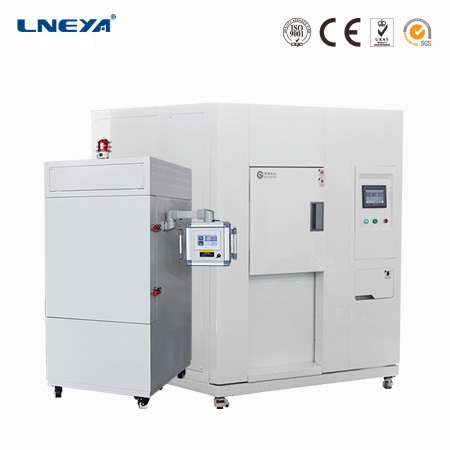High temperature fault treatment of temperature shock test equipment
The whole function of Wuxi Guanya LNEYA thermal shock test chamber is computer controlled. It is a self-developed software with a good operation interface, which makes the operation and monitoring of the user simpler and more intuitive. The maintenance function can keep the running program in your operation. In the current state, the value of this block can be temporarily changed. The time parameter can be set on the screen to make the cooling, heating, and blue transfer switch automatically, according to the set value. The cold box and the hot box are independently controlled, and the box doors are independent of each other, and the use range of the test box is expanded (one box and three uses). The thermal shock effect of the temperature impact test equipment can be fully guaranteed. The test box door is interlocked with the circulating fan and the blue drive to protect the operator’s safety. Once the door is opened, the power of the circulating fan and the blue drive will be automatically cut off.
The cause of the high-voltage failure of the temperature shock test equipment may be that the cooling water flow is insufficient and the rated water flow rate is not reached. The main performance is that the pressure difference between the unit inlet and outlet water becomes smaller (compared with the pressure difference at the beginning of the system operation), and the temperature difference becomes larger. The reason for the lack of water flow is that the system is short of water or air. The solution is to install an exhaust valve at the high point of the pipeline to exhaust; the pipeline filter is blocked or too fine, and the water permeability is limited. A suitable filter should be used. Clean the filter regularly; the pump is small and not compatible with the system.
The temperature impact test equipment condenser is fouled or clogged. Condensed water is generally tap water, it is easy to scale at 30 ° C or above, and because the cooling tower is open, it is directly exposed to the air, dust foreign matter can easily enter the cooling water system, causing the condenser to be blocked and the heat exchange area is small. It is inefficient and affects water flow. The performance is that the pressure difference between the inlet and outlet water of the unit is large, and the temperature difference is large. The temperature above and below the condenser is high, and the copper tube of the condenser is hot. The unit should be backwashed regularly and chemically cleaned and descaled if necessary.
The temperature shock test equipment has too much refrigerant charge. This situation generally occurs after maintenance, which is characterized by high suction and discharge pressure, equilibrium pressure, and high compressor operating current. It should be vented according to the suction and exhaust pressure and the equilibrium pressure and the operating current under rated conditions until normal. The temperature impact test equipment is mixed with non-condensable gases such as air and nitrogen in the refrigerant. This situation usually occurs after maintenance, and the vacuum is not complete. Can only be drained, re-vacuum, refill the refrigerant.

False alarm caused by electrical failure of temperature shock test equipment. Due to the moisture, poor contact or damage of the high voltage protection relay, the unit electronic board is damp or damaged, and the communication failure causes a false alarm. This kind of false fault, often the HP fault indicator on the electronic board is not bright or slightly bright, the manual reset of the high voltage protection relay is invalid, the computer displays “HPRESET”, or it disappears automatically, the compressor running current is normal, and the suction and exhaust pressure is also normal. .
If the high-voltage fault of the temperature shock test equipment occurs, it needs to be solved in time to avoid the big fault caused by the small fault and cannot be used in time.
 LNEYA Industrial Chillers Manufacturer Supplier -
LNEYA Industrial Chillers Manufacturer Supplier -












